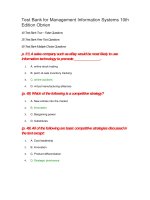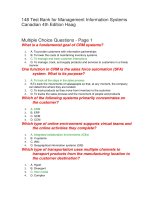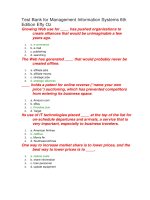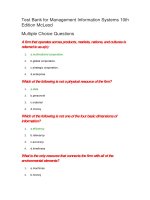158 test bank for management 11th edition daft
Bạn đang xem bản rút gọn của tài liệu. Xem và tải ngay bản đầy đủ của tài liệu tại đây (188.08 KB, 38 trang )
Test Bank for Management 11th Edition Daft
Multiple Choice Questions - Page 1
Which of the following is a bar graph that measures planned and
completed work along each stage of production by time elapsed?
1.
a.Time and Work chart
2.
b.Gantt chart
3.
c.Time and Motion chart
4.
d.Production and Delivery chart
5.
e.Gilbreth chart
The assembly line is most consistent with which of the following general
principles of management?
1.
a.Unity of command
2.
b.Division of work
3.
c.Authority
4.
d.Scalar chain
5.
e.Quality management
Whereas scientific management focused on _____ , administrative
principles approach focused on the _____.
1.
a.individual productivity; total organization
2.
b.organization productivity; individual effort
3.
c.efficient procedures; management by principle
4.
d.employee ability; employee loyalty
5.
e.employee competence; work flow through the organization
Jessica is a recent college graduate who is seeking a job that includes
telecommuting, shared jobs, flextime, and organization-sponsored
sabbaticals. Based on this information, Jessica most likely belongs to
which demographic group?
1.
a.Baby Boomer
2.
b.Generation X
3.
c.Generation Y
4.
d.Generation Z
5.
e.Tweener
Positions organized in a hierarchy of authority is an important
characteristic of:
1.
a.scientific management.
2.
b.bureaucratic organizations.
3.
c.quantitative management.
4.
d.the human relations movement.
5.
e.total quality management.
Standardization of work and wage incentives are characteristics of:
1.
a.bureaucratic organizations.
2.
b.scientific management.
3.
c.quantitative management.
4.
d.administrative management.
5.
e.behavioral science.
An innovation mindset that strives to meet customers’ immediate needs
quickly and inexpensively is referred to as:
1.
a.kaizen.
2.
b.just-in-time control.
3.
c.total quality management.
4.
d.jugaad.
5.
e.XY Theory.
The findings provided by the Hawthorne Studies provided the impetus for
the _____, despite flawed methodology or inaccurate conclusions.
1.
a.classical perspective
2.
b.humanistic perspective
3.
c.scientific management
4.
d.bureaucratic organizations
5.
e.contingency perspective
Frank Gilbreth felt that efficiency equated with:
1.
a.one best way to do work.
2.
b.leadership flows from the top down.
3.
c.procedures and policies.
4.
d.scientific management.
5.
e.bureaucracy.
According to Weber's ideas on bureaucracy, organizations should be
based on which of these?
1.
a.Personal loyalty
2.
b.Personal references
3.
c.Rational authority
4.
d.Family ties
5.
e.Charismatic authority
Chester Bernard felt that _____ could help a poorly managed
organization.
1.
a.bureaucracy
2.
b.line managers
3.
c.efficiencies
4.
d.informal relations
5.
e.top/down flow of information
Which of the following is not a criticism of scientific management?
1.
a.It does not appreciate the social context of work.
2.
b.It does not appreciate the higher needs of workers.
3.
c.It does not appreciate the careful study of tasks and jobs.
4.
d.It does not acknowledge variance among individuals.
5.
e.It tends to regard workers as uninformed and ignored their ideas and
suggestions.
The _____ refers to a chain of authority extending from top to the bottom
of the organization and including every employee.
1.
a.unity of command
2.
b.division of labor
3.
c.unity of direction
4.
d.scalar chain
5.
e.none of these
Matrix Dress Designs operates using the concept of empowerment, where
employees act independently and with management facilitating rather
than controlling workers. These qualities represent which management
approach?
1.
a.Administrative principles approach
2.
b.Bureaucratic approach
3.
c.Scientific management approach
4.
d.Humanistic approach
5.
e.Behavioral sciences approach
The use of specialization to produce more and better work with the same
level of effort is consistent with the administrative management principle
of:
1.
a.unity of command.
2.
b.unity of direction.
3.
c.scalar chain.
4.
d.division of work.
5.
e.none of these
Time and motion studies that resulted in drastic reduction in the time
patients spent on the operating table were pioneered by _____.
1.
a.Edward Deming
2.
b.Henry Gantt
3.
c.Max Weber
4.
d.Mary Parker Follett
5.
e.Frank Gilbreth
_____ forces refer to those aspects of a culture that guide and influence
relationships among people.
1.
a.Social
2.
b.Political
3.
c.Economic
4.
d.Technological
5.
e.Legal
Frederick Taylor's contributions were in the field of:
1.
a.scientific management.
2.
b.human resource management.
3.
c.human relations.
4.
d.quantitative management.
5.
e.total quality management.
Mary Parker Follett contributed to which field?
1.
a.Humanistic approach
2.
b.Scientific management approach
3.
c.Total quality management approach
4.
d.Quantitative approach to management
5.
e.Systems approach to management
The three subfields of the classical perspective include:
1.
a.quantitative management, behavioral science, and administrative management.
2.
b.bureaucratic organization, quantitative management, and the human relations
movement.
3.
c.administrative management, bureaucratic organization, and scientific
management.
4.
d.scientific management, quantitative management, and administrative
management.
5.
e.none of these.
Strong anti-American sentiments in many parts of the world exemplify the
effect of:
1.
a.economic forces.
2.
b.political forces.
3.
c.demographic forces.
4.
d.technological forces.
5.
e.human relations forces.
Mary Parker Follett thought of leadership as _____, rather than
techniques.
1.
a.systems
2.
b.top managers
3.
c.people
4.
d.efficiencies
5.
e.floor managers
Who is considered the "first lady of management?"
1.
a.Mary Parker Follett
2.
b.Lillian Gilbreth
3.
c.Carly Fiorona
4.
d.Maxine Weber
5.
e.Anne Adams
All of the following are characteristics of Weberian bureaucracy except:
1.
a.labor is divided with clear definitions of authority and responsibility that are
legitimized as official duties.
2.
b.positions are organized in a hierarchy of authority, with each position under the
authority of a higher one.
3.
c.all personnel are selected and promoted based on technical qualifications.
4.
d.administrative acts and decisions are recorded in writing.
5.
e.management is the same as the ownership of the organization.
UPS is successful in the small package delivery market. One important
reason for this success is the concept of:
1.
a.globalization.
2.
b.employee flexibility.
3.
c.loose standards.
4.
d.bureaucracy.
5.
e.non-bureaucratic organizational system.
Max Weber felt selection of employees should be based on _____.
1.
a.education
2.
b.competence
3.
c.connections
4.
d.political skills
5.
e.efficient systems
The bureaucratic organizations approach is a subfield within the _____.
1.
a.classical perspective
2.
b.systems theory
3.
c.scientific management
4.
d.learning organization
5.
e.management science view
_____ is the most current management perspective.
1.
a.Total quality management
2.
b.Contingency views
3.
c.Systems theory
4.
d.Open (collaborative) innovation
5.
e.Classical perspective
Genex Dynamics is a ballistics company that uses the unity of command,
scalar chain, and division of work principles. These are part of which
management philosophy?
1.
a.Administrative principles approach
2.
b.Bureaucratic approach
3.
c.Scientific management approach
4.
d.Humanistic approach
5.
e.Behavioral sciences approach
Which of these perspectives emphasized a rational, scientific approach to
the study of management and sought to make organizations efficient
operating machines?
1.
a.The Humanistic Perspective
2.
b.The Behavioral Sciences Approach
3.
c.The Classical Perspective
4.
d.The TQM approach
5.
e.The Quantitative Management Approach
Archies' Antiques, Inc., is characterized by separation of management
from ownership and by clearly defined lines of authority and
responsibility. These characteristics are consistent with the principles of:
1.
a.scientific management.
2.
b.bureaucratic organizations.
3.
c.administrative management theory.
4.
d.human resource management.
5.
e.all of these.
The principle that similar activities in an organization should be grouped
together under one manager is the essence of the classical perspective
known as:
1.
a.unity of command.
2.
b.division of work.
3.
c.unity of direction.
4.
d.scalar chain.
5.
e.quality management.
A key finding in the Hawthorne studies was which of these?
1.
a.Stronger lighting increased productivity.
2.
b.More money resulted in increased productivity.
3.
c.Productivity declined in all experiments.
4.
d.Higher temperatures reduced productivity.
5.
e.Human relations increased productivity.
A(n) _____ perspective provides a broader way of thinking, a way of
searching for patterns, and determining whether they recur across time
periods.
1.
a.analytical
2.
b.futuristic
3.
c.systematic
4.
d.methodical
5.
e.historical
Which of these forces comprises unwritten, common rules and
perceptions about relationships?
1.
a.Economic forces
2.
b.Political forces
3.
c.Social forces
4.
d.Legal forces
5.
e.Personal forces
Which of these is a subfield of the classical management perspective that
emphasized scientifically determined changes in management practices
as the solution to improving labor productivity?
1.
a.The human relations movement
2.
b.The behavioral sciences approach
3.
c.The TQM approach
4.
d.The quantitative management approach
5.
e.The scientific management movement
_____ is considered the "father of scientific management."
1.
a.Frank B. Gilbreth
2.
b.Elton Mayo
3.
c.Henry Gantt
4.
d.Douglas McGregor
5.
e.Frederick W. Taylor
Which of these is a major criticism of scientific management?
1.
a.It ignored the social context of work.
2.
b.It ignored the impact of compensation on performance.
3.
c.It overemphasized individual differences.
4.
d.It overemphasized the intelligence of workers.
5.
e.It emphasized the social context of work.
The nineteenth and early twentieth centuries saw the development of
which management perspective?
1.
a.The human relations movement
2.
b.The behavioral sciences approach
3.
c.The classical perspective
4.
d.The quantitative management approach
5.
e.The TQM approach
Which of these forces pertain to the availability, production, and
distribution of resources in a society?
1.
a.Social
2.
b.Political
3.
c.Economic
4.
d.Technological
5.
e.Legal
81 Free Test Bank for Management 11th Edition Daft
Multiple Choice Questions - Page 2
The most recent subfield of the quantitative perspective is _____, which is
reflected in management information systems designed to provide
relevant information to managers in a timely and cost-efficient manner.
1.
a.operations research
2.
b.operations management
3.
c.information technology
4.
d.systems thinking
5.
e.infrastructure development
The human resources perspective of management links motivation
theories with _____.
1.
a.top management
2.
b.employee tasks
3.
c.floor managers
4.
d.efficiencies
5.
e.profit maximization
From the 1950s until today, which management perspective has remained
the most prevalent?
1.
a.Systems
2.
b.Qualitative
3.
c.Scientific management
4.
d.Quantitative
5.
e.Humanistic
Organizational development is one specific set of management
techniques based in the _____ approach.
1.
a.management science
2.
b.systems theory
3.
c.behavioral sciences
4.
d.scientific management
5.
e.quantitative
Which of the following uses the latest information technology to keep in
close touch with customers and to collect and manage large amounts of
customer data?
1.
a.Supply Chain Management
2.
b.Learning Organizations
3.
c.Scientific Management
4.
d.Customer Relationship Management
5.
e.The Humanistic Approach
According to Douglas McGregor, the classical perspective on
management is consistent with which of the following?
1.
a.Theory X manager
2.
b.Theory Y manager
3.
c.Theory Z manager
4.
d.Theory A manager
5.
e.None of these
According to the Manager's Shoptalk of chapter 2, Latin American
executives are more less to use tools such as:
1.
a.customer segmentation and business process reengineering.
2.
b.consumer ethnography and corporate blogs.
3.
c.downsizing.
4.
d.activity-based management and virtual teams.
5.
e.scenario planning and lean operations.
In order to determine how to deal with a problem employee, Sharon
evaluated the employee, the problem, and the context in which the
problem occurred. She is applying which of the following perspectives?
1.
a.Participative view
2.
b.Universalist view
3.
c.Autonomy view
4.
d.Contingency view
5.
e.Humanist view
Which of the following refers to financial managers and others who base
their decisions on complex quantitative analysis, under assumption that
using advanced mathematics and technology can accurately predict how
the market works?
1.
a.Stems
2.
b.Yuppies
3.
c.Quals
4.
d.Quants
5.
e.Fins
10 + 10 = 25 reflects which of these?
1.
a.Entropy
2.
b.Synergy
3.
c.Open system
4.
d.Closed system
5.
e.Weberian math
The _____ emphasized the importance of understanding human
behaviors, needs, and attitudes in the workplace as well as social
interactions and group processes.
1.
a.humanistic perspective
2.
b.classical perspective
3.
c.scientific management
4.
d.bureaucratic organizations
5.
e.contingency perspective
The management science perspective applies all of the following to
managerial problems EXCEPT:
1.
a.statistics.
2.
b.qualitative techniques.
3.
c.mathematics.
4.
d.quantitative techniques.
5.
e.all of these are correct.
The management science perspective emerged after World War II to treat
problems associated with:
1.
a.modern global warfare.
2.
b.environmental issues.
3.
c.employee involvement.
4.
d.Germany.
5.
e.improving manufacturing.
A significant contribution of Chester Barnard was the concept of:
1.
a.bureaucracy.
2.
b.the informal organization.
3.
c.total quality management.
4.
d.scientific management.
5.
e.traditional theory of authority.
The behavioral sciences approach is based on which of the following
disciplines?
1.
a.Anthropology
2.
b.Economics
3.
c.Sociology
4.
d.Psychology
5.
e.All of these
Theory X and Theory Y was developed by _____.
1.
a.Douglas McGregor
2.
b.Henry Gantt
3.
c.Max Weber
4.
d.Mary Parker Follett
5.
e.Frank Gilbreth
Most early interpretations of the Hawthorne studies argued that the factor
that best explained increased output was _____.
1.
a.money
2.
b.days off
3.
c.human relations
4.
d.lighting
5.
e.free food
A social group within an organization is part of the:
1.
a.formal organizational structure.
2.
b.informal organization.
3.
c.scalar chain.
4.
d.reorganization process.
5.
e.top management level.
Georgia, an airline CEO, often looks for patterns of movement within the
airline industry, focusing on the qualities of rhythm, flow, direction, shape,
and networks of relationships. This type of activity, referred to as _____
thinking, allows Georgia to see the structures that underlie complex
situations within the industry and company.
1.
a.systems
2.
b.qualitative
3.
c.quantitative
4.
d.conceptual
5.
e.contingency
It is often difficult to make decisions about subsystems because they are
_____.
1.
a.interdependent
2.
b.independent
3.
c.managed differently
4.
d.filled with employees
5.
e.organizationally based
Which of the following is often considered the "father of the quality
movement?"
1.
a.Weber
2.
b.Gilbreth
3.
c.Follett
4.
d.Deming
5.
e.Gehrke
The Forestville Freeze is regionally known for its employee training
programs. Managers at the Freeze conduct research to determine the best
candidate interviewing techniques. This involves the use of which
management approach?
1.
a.Administrative principles approach
2.
b.Bureaucratic approach
3.
c.Behavioral sciences approach
4.
d.Humanistic approach
5.
e.Scientific management approach
_____ is a process whereby companies find out how others do something
better than they do and then try to imitate or improve on it.
1.
a.TQM
2.
b.Continuous improvement
3.
c.Benchmarking
4.
d.Empowerment
5.
e.MBO
Tommy believes his employees are responsible, creative, and able to work
with minimal direction. He is a:
1.
a.theory X manager.
2.
b.theory Y manager.
3.
c.theory Z manager.
4.
d.theory A manager.
5.
e.contingency theory manager.
A consultant who recommends the effectiveness of sensitivity training to
every organization he serves is violating the basics of which of the
following perspectives?
1.
a.Efficiency perspective
2.
b.Universalist perspective
3.
c.Contingency perspective
4.
d.Scientific management perspective
5.
e.Quantitative perspective
A "dairy farm" view of management, i.e., contented cows give more milk,
so satisfied workers will give more work was espoused by:
1.
a.human relations management.
2.
b.human resource perspective.
3.
c.behavioral science approach.
4.
d.management science perspective.
5.
e.none of these.
The teamwork philosophy is based in part on the assumption that five
people working together can produce more than five people working
individually. This philosophy is consistent with the concept of _____.
1.
a.transformation
2.
b.entropy
3.
c.synergy
4.
d.feedback
5.
e.quality
_____ focuses on managing the whole organization to deliver quality to
customers.
1.
a.Bureaucracy
2.
b.Theory Z
3.
c.Management-by-objective
4.
d.Total quality management
5.
e.Organization-customer relationship
Which of these refers to the management thinking and practice that
emphasizes satisfaction of employees' basic needs as the key to
increased worker productivity?
1.
a.Scientific management perspective
2.
b.Human resource perspective
3.
c.Management science perspective
4.
d.Behavioral sciences approach
5.
e.Human relations movement
According to the Manager's Shoptalk of chapter 2, which of the following
is not in the top five contemporary management tools?
1.
a.Collaborative innovation
2.
b.Mission and vision statements
3.
c.Benchmarking
4.
d.Strategic planning
5.
e.Customer relationship management
In _____, every situation is viewed as unique.
1.
a.a universalist view
2.
b.a contingency view
3.
c.a case view
4.
d.a scientific management view
5.
e.none of these
Beth Brant, production supervisor at Trustworthy Tools Mfg., Inc. believes
that her employees dislike work, avoid responsibility, and therefore they
need to be controlled and directed. Beth is a:
1.
a.theory X manager.
2.
b.theory Y manager.
3.
c.realistic manager.
4.
d.theory Z manager.
5.
e.theory J manager.
Which of the following is identified as a recent trend that has staying
power?
1.
a.Corporate takeovers
2.
b.Hedging
3.
c.Insourcing
4.
d.Relationship management
5.
e.Task management
After decades of being a manager, Jeffrey has learned that an
organizational structure that is effective for one company is likely to be
ineffective for a different company. This knowledge reflects which current
management perspective?
1.
a.Systems thinking
2.
b.Contingency view
3.
c.Total quality management
4.
d.Benchmarking
5.
e.Scientific management view
_____ specifies a goal of no more than 3.4 defects per million parts.
1.
a.Benchmarking
2.
b.Total quality management
3.
c.Six sigma
4.
d.Balanced scorecard
5.
e.Jugaad
Within his role as a financial accountant, Roger uses the capital asset
pricing model and other mathematical tools to help clients keep track of
their finances. Which perspective or approach does Roger apply most at
his work?
1.
a.Quantitative perspective
2.
b.Qualitative perspective
3.
c.Humanistic approach
4.
d.Behavioral science approach
5.
e.Scientific management approach
Maslow's hierarchy of needs started with which of these needs?
1.
a.Esteem
2.
b.Love
3.
c.Safety
4.
d.Physiological
5.
e.Belongingness
The implementation of small incremental improvements in all areas of the
organization on an ongoing basis is referred to as:
1.
a.benchmarking.
2.
b.empowerment.
3.
c.systems theory.
4.
d.contingency perspective.
5.
e.continuous improvement.
Elements of TQM include:
1.
a.employee detachment.
2.
b.focus on profits.
3.
c.benchmarking.
4.
d.accidental improvement.
5.
e.all of these.
Operations research grew out of World War II groups and is based on
_____.
1.
a.group dynamics
2.
b.employees in crisis
3.
c.production in turbulent times
4.
d.mathematical equations
5.
e.a humanistic approach
Which of the following refers to managing the sequence of suppliers and
purchasers, covering all stages of processing from obtaining raw
materials to distributing finished goods to consumers?
1.
a.E-commerce
2.
b.E-business
3.
c.Supply chain management
4.
d.Knowledge management
5.
e.Customer relationship management
True - False Questions
With clear definitions of authority and responsibility, division of labor is
one of the six characteristics of the ideal bureaucracy.
1.
True
2.
False
The term “quants” refers to financial managers and others who base their
decisions on complex quantitative analysis, under assumption that using
advanced mathematics and technology can accurately predict how the
market works.
1.
True
2.
False
Discerning circles of causality is an important element of systems
thinking.
1.
True
2.
False
Unfortunately, Mary Parker Follett's approach to leadership stressed the
importance of engineering techniques rather than people.
1.
True
2.
False
Administrative acts and decisions recorded in writing is one of the six
characteristics of the ideal bureaucracy.
1.
True
2.
False
The scientific management perspective refers to the management thinking
and practice that emphasizes satisfaction of employees' basic needs as
the key to increased worker productivity.
1.
True









